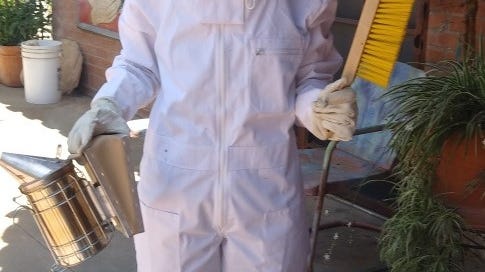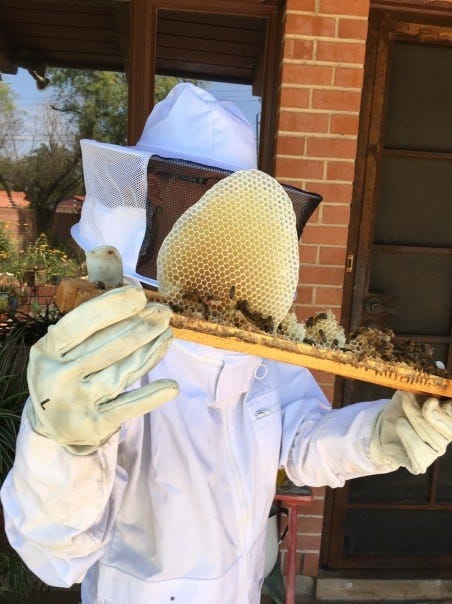A couple years ago, for the shortest of times, I was a bee keeper’s apprentice. Or, since I was only there a couple hours, maybe it was more like an intern. Or an aide. Or maybe just a person trying to avoid a stinging. Whatever the non-title, I was in the backyard of an acquaintance who’d been bee-keeping for quite some time across town and she’d offered to show me the ropes.
We suited up in protective gear, and ‘Patty’ issued instructions: Be quiet, don’t wave my arms, stay out of the bee line (the path bees took over her fence to get back to the hive) and ‘smoke’ the bees when she requested. She explained that the only person who’d ever been stung by her bees was her husband because he had insisted he could tend the hive without the bee keeper outfit. He learned that, actually, he could not.
I followed Patty to the hive, smoker at the ready. She demonstrated how and where to puff the smoke, and I set to work, learning that smoke sedates bees in some way that makes them less likely to send “Swarm the intruder!” messages to each other. I didn’t fully comprehend this bee-communication system because I was mightily distracted by one determined bee persistently dive-bombing my face netting.
“Hello, daughter,” I said calmly, standing statue-still and mimicking how I’d heard Patty talk to her bees. The dedicated insect gave up a few minutes later and I breathed more easily.
Patty carefully lifted a honeycomb frame from the hive and passed it to me. I held it awkwardly in my massive gloved hands, like trying to hold a newborn with baseball gloves. Then I brushed off the bees clinging to the honeycomb gently with a giant bee brush before setting the now bee-free comb into a waiting bucket.
I learned so much in the couple of hours I was with Patty — about drones versus workers, the brood nest, ‘hive glue’ and how a colony raises a queen. I wish I remembered it all, but, like with most things we don’t practice regularly (Algebra, anyone?) much of it has leaked out of my head.
Except for this one thing: You want to work your hives with the sun in high in the sky so you don’t cast a shadow over the hive. This is because bees know when their hives are in the sun and when they are in the shade - because truly, folks, these animals are brilliant - and get agitated if an unexpected shadow appears. Apparently, they don’t like surprises.
People aren’t that different from bees in that way: No matter how adaptable we proclaim to be, most of us don’t like unexpected change. We are, like most of the animal kingdom, creatures of habit. Heck, I know people who get upset if they show up to church and someone is sitting in ‘their’ pew, and others who get punchy if someone is in the kitchen when they assumed they’d be there alone. Like I said: Creatures of habit.
So it probably shouldn’t be any surprise that the pace of change in the past 12 years – from the weather and the pandemic to book bans and transgender rights – has been like an unexpected shadow producing anxiety in this country. The problem is, half the country is anxious about this shadow and the other half is anxious about that shadow, and the disagreement about what is really the danger has led to anger and massive mistrust.
There are a bazillion reasons for this scared-of-shadows state of affairs, but as I wrote a few years ago, I think the primary one is no common news source. Thirty years ago, most people got a daily newspaper dropped in their driveway and watched just 30 minutes of TV news, usually in the evening between 5 and 6 p.m. Even though CNN launched in 1980 as the first 24-7 news station, most Americans were still getting their news from newspapers and traditional broadcast until well into the 1990s.
That changed in 1996, when FOX and MSNBC launched competing right/left cable ‘news’ channels, and the race for eyeballs took off. It was the beginning of the loss of quality journalism, because the only way to keep people glued to their TV 24/7 is by focusing on scandals, drama and – you guessed it – fear. All shadows, all the time, agitating all of us.
I could say this was manufactured by conservative power-brokers who want to take us back to the 1950s, and I wouldn’t be completely wrong. I could also say it was fed by the move-fast-and-break-things tech bros who would rather get rich than consider the consequences of information silos, and I wouldn’t be completely wrong.
But knowing why it happened matters little right now. We are where we are, and anyone who’s tried to grow a tomato lately or pay for health care or buy a house or talk to their neighbor knows things aren’t great. We need solutions, not another postmortem of what is wrong, and we can’t get to solutions if we’re divided. We need to learn the art of compromise again and save the darn country, people. (You’re a purist who thinks compromise is for the weak? Please go stand in the corner.)
If bees can build this:
… surely we can solve the problems facing us together.
But first, we have to learn to listen to each other again. I know we used to have that listening skill, but our phones have extinguished it and only Australia seems to have the guts to attack that public health crisis head-on. So we have to commit to changing the world where we are, one step at a time. We need to start meeting in IRL again and listening well so Person A can understand that the things Person B wants in this country are just as important as the things Person A wants, and vise versa, and everyone can understand that none of us will get everything we want, but we should both get some of what we want. We have to stop letting the perfect be the enemy of the good. Some progress is better than none, no matter how hard the extremes on the right and left work to convince us otherwise.
And yes, I know it is sooooooooooooo frustrating to try to make nice with people who’ve been spun up into anger the past 12 years by talk show hosts getting rich off of outrage. It’s hard to listen well to a person who is refusing to consider your side. But you know what? The only way we’re going to “Get shit done” is by working together.
So, for heaven’s sake, turn off the news, take social media off your phones, read a book (or thoughtful, nuanced Substacks like this one), and pull out your baking pans. Because this episode of Swing For The Joy is asking you to bake the recipe below for a neighbor who voted for the other side. Yes, I’m looking at you, Trump voters. And you, Harris voters. Everyone should be baking and giving, which will lead to not hating.
I know it won’t always work. There’s a guy in my neighborhood who is – how can I put this politely? – a jerk. Get-off-my-lawn cranky, hateful-political-signs crabby, brush-bikes-in-the-road schmuck. He’s big on name-calling and crass language and thinks it’s “just a joke” to make fun of people who aren’t like him. He’s so miserable that when my just-turned-4-year-old grandson – who regularly chirps “Hello!” and waves his tiny mitt of a hand wildly at everyone he sees – did that with Mr. Cranky-pants, the creep turned his back and stomped away. So, yeah, baked goods aren’t changing that man.
But just because he’ll never open his mind to seriously consider another person’s view doesn’t mean I’ll give up on the rest of my neighbors, relatives, colleagues and the lady sitting next to me at Mass. Because, friends, all we have is each other. So, get to baking, then let me know how it goes.
CHOCOLATE CHIP BARS
I like bars because they’re way faster than cookies. This makes a 9 x 11-inch pan of 1-inch-tall bars that you can cut into 2-inch squares and divide up among at least three neighbors. Watch the bars closely when baking to get the timing just right. So much depends on your oven!
PREHEAT OVEN TO 350 degrees
1. Cream together with a mixer (hand or stand):
2/3 cup shortening (this is my mother’s recipe from the 50s, when shortening was queen. If you can’t get yourself to use it, 2/3 cup of unsalted butter will also work)
1 ¼ cup brown sugar
2. Add two eggs to shortening/sugar mixture and mix well.
3. Sift together in a separate bowl:
1 ¼ cup all-purpose flour
1 ¼ teaspoon baking powder
¼ teaspoon salt
4. Add flour mixture to the shortening/sugar/egg mixture and mix well.
5. Stir in ½ cup chocolate chips and ½ cups chopped walnuts or pecans. The batter should be just slightly thinner than cookie dough. (Nuts are optional but super tasty and, if you use walnuts, the recipe technically becomes brain food!)
6. Spread into a buttered & floured 9 x 11-in pan.
7. Bake at 350 for 20 to 35 minutes. Check with a toothpick/knife/chopstick for done-ness beginning at 20 minutes and every few minutes after. Years of baking have taught me every oven bakes differently (and glass versus metal pans matter as well), so once you know what works for your oven, write that down for the next time you use the recipe.
Note: If you, like me, sometimes want some ‘health’ in your sugared treat, you can make this recipe with half whole wheat flour; if you do this, add 1-3 tablespoons of water, 1 tablespoon at a time, to the batter after adding the flour mixture. You have to do this part by feel. The batter should be just slightly wetter/thinner than cookie dough when mixing is complete.






What a wonderful post! It informs and inspires—a perfect balance!
Love this post Renee -- a wonderful perspective. Looking forward to more!